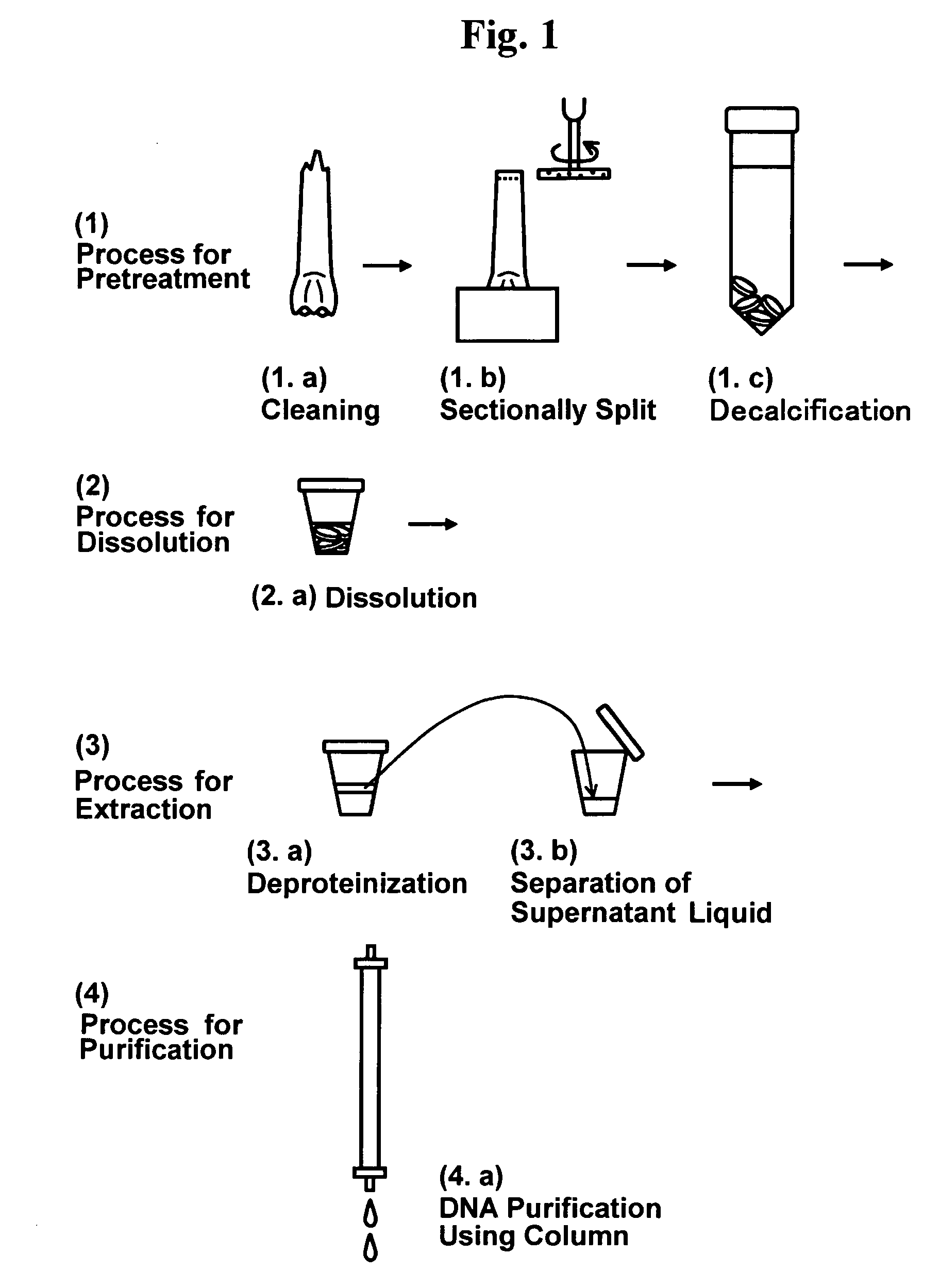Method for extracting DNA from sample of organism
- Summary
- Abstract
- Description
- Claims
- Application Information
AI Technical Summary
Benefits of technology
Problems solved by technology
Method used
Image
Examples
example 1
[0055] A tooth was scrubbed with a brush soaked in a neutral detergent to remove the adherents from the surface thereof. Sterilized distilled-water was then squirted thereto to wash the neutral detergent away. After that, ethanol was squirted thereto and then dried off with a dryer swiftly.
[0056] The tooth was put onto a wooden cubic base having each side of about 3 cm. 1 or 2 drops of an instant adhesive: aron alpha, which is a registered trademark and available from TOAGOSEI CO., LTD., were dropped into a clearance between the tooth and the base in order to fasten them together. In a clear plastic sheet made from vinyl polymer, a region of tooth root was cut to fragments having 0.1 cm or thicker with a discotic grinder to quarry 1 to 6 disc pieces. By lifting up and shaking the disc piece, the pieces attached no powder were obtained.
[0057] These 1 to 6 pieces were inserted into a tube for culture having 50 mL volume. To 30 to 50 mL of 0.5 M EDTA aqueous solution (pH 8.0), which ...
example 2
[0062] A tooth was scrubbed with a brush soaked in a neutral detergent to remove the adherents from the surface thereof. Sterilized distilled-water was then squirted thereto to wash the neutral detergent away. After that, ethanol was squirted thereto and then dried off with a dryer swiftly.
[0063] The whole tooth was inserted into a tube for culture having 50 mL volume. To 30 to 50 mL of 0.5 M EDTA aqueous solution (pH 8.0), which is a trade name and available from Wako Pure Chemical Industries, Ltd., SDS was added and regulated as 0.1 weight %, and then this solution was added to the tube. It was incubated at 37 to 50° C. for 12 hours to decalcify. The pieces of the tooth were moved to another tube for culture having 2 mL volume and washed with 700 μL of 0.5 M EDTA aqueous solution (pH 8.0). The EDTA aqueous solution in the tube was sucked out with a pipette.
[0064] As a buffer solution of a solubilizer, 100 to 200 μL of a resolvable solution including 10 mM of Tris hydrochloide, 1...
PUM
| Property | Measurement | Unit |
|---|---|---|
| Temperature | aaaaa | aaaaa |
| Temperature | aaaaa | aaaaa |
| Temperature | aaaaa | aaaaa |
Abstract
Description
Claims
Application Information
 Login to View More
Login to View More - R&D
- Intellectual Property
- Life Sciences
- Materials
- Tech Scout
- Unparalleled Data Quality
- Higher Quality Content
- 60% Fewer Hallucinations
Browse by: Latest US Patents, China's latest patents, Technical Efficacy Thesaurus, Application Domain, Technology Topic, Popular Technical Reports.
© 2025 PatSnap. All rights reserved.Legal|Privacy policy|Modern Slavery Act Transparency Statement|Sitemap|About US| Contact US: help@patsnap.com

